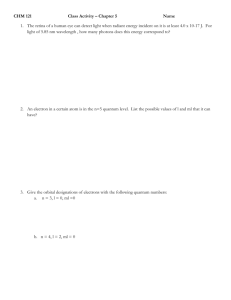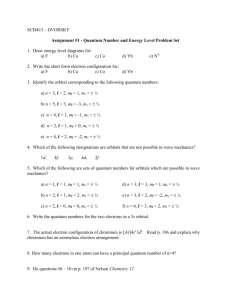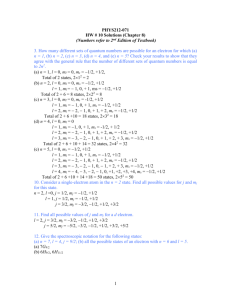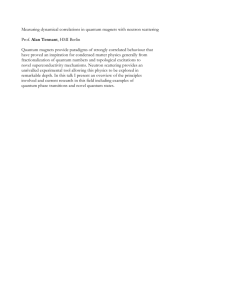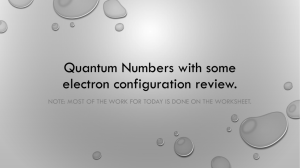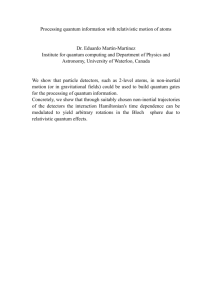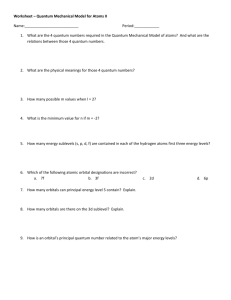Tunnel FETs, Quantum devices
advertisement
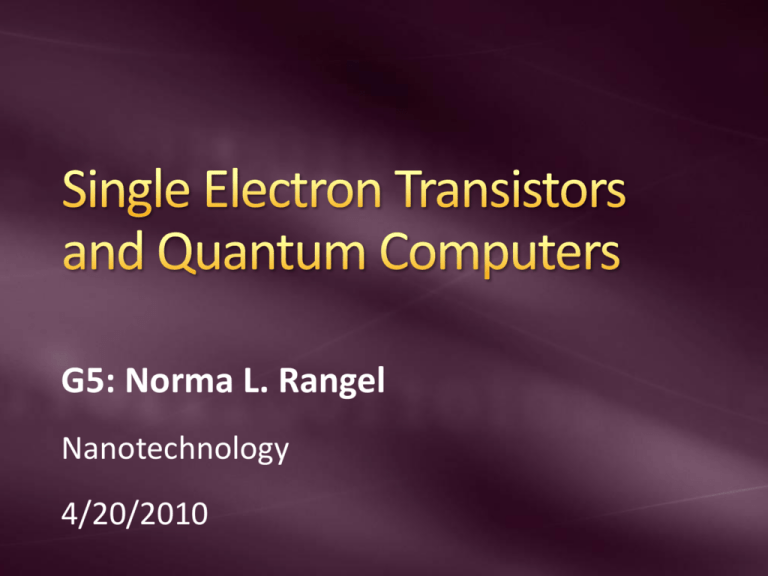
G5: Norma L. Rangel
Nanotechnology
4/20/2010
Ellenbogen 2000
Conventional Transistors
Single Electron Transistors
Coulomb Island
Coulomb Blockade
Coulomb Gap Energy
Tunneling
Applications of SETs
Quantum Computers: NATURE, Vol 464, 03-2010
Transistors
Fundamental
component in
almost all
electronic devices
BJT
NPN
Electrons
FET
PNP
holes
• A transistor can be used as a switch and as
amplifier
• Manufactured in different shapes but they
have three leads: BASE (gate controller device),
COLLECTOR (larger electrical supply, source)
AND EMITTER (the outlet for that supply)
JFET
MOSFET
A junction transistor: a thin piece of one type of
semiconductor material between two thicker layers of
the opposite type.
A field effect transistor: Electricity flows through one of
the layers, called the channel. The voltage connected
to the gate controls the strength of the current in the
channel.
http://www.physlink.com/Education/AskExperts/ae430.cfm
Switching device that uses controlled electron
tunneling to amplify current.
A SET is made from two tunnel junctions that share a
common electrode.
An AFM picture of a single-electron transistor (SET).
The red region, the island where only single electrons may
be admitted.
Schumacher et al., Applied Physics Letters
Tunnel Junction
A tunnel junction consists of two pieces
of metal separated by a very thin (~1 nm)
insulator.
The only way for electrons in one of the metal
electrodes to travel to the other electrode is to
tunnel through the insulator.
Since tunneling is a discrete process, the
electric charge that flows through the tunnel
junction flows in multiples of e, the charge of a
single electron.
Tunneling
Quantum tunneling refers to the phenomena of
a particle's ability to penetrate energy barriers
within electronic structures.
Schematic representation of
quantum tunnelling through a
barrier.
The energy of the tunneled
particle is the same, only the
quantum amplitude (and
hence the probability of the
process) is decreased.
http://en.wikipedia.org/wiki/Quantum_tunnelling
The SET is made by placing 2 tunnel junctions in series
The 2 tunnel junction create what is known as a
“Coulomb Island” that electrons can only enter by
tunneling through one of the insulators.
This device has 3 terminals like the FETs.
The cap may seem like a third tunnel junction, but is
much thicker than the others so that no electrons
could tunnel through it.
The cap simply serves as a way of setting the electric
charge on the coulomb island.
controlled
by light
irradiation
When a capacitor is charged through a resistor, the
charge on the capacitor is proportional to the
applied voltage and shows no sign of quantization.
When a tunnel junction replaces the resistor, a
conducting island is formed between the junction and
the capacitor plate. In this case the average charge on
the island increases in steps as the voltage is
increased -> Low self capacitance
The steps are sharper for more resistive barriers and at
lower temperatures.
Charge passes through the
island in quantized units.
The energy must equal the
coulomb energy e^2/2Cg.
Coulomb blockade, As the
bias voltage between the
source and drain is increased,
an electron can pass through
the island when the energy in
the system reaches the
coulomb energy.
The critical voltage needed to
transfer an electron onto the
island equal to e/C, is called
the coulomb gap energy.
The effect in which electron can not pass
through the island unless the energy in the
system is equal to the coulomb energy e^2/Cg.
The thermal energy kBT must be below the
charging energy or the electron will be able
to pass the quantum blockade via thermal
excitation
Coulomb blockade tries to alleviate any leak by
current during the off state of the SET.
Capacitance of the island must be less than 10^17 Farads and therefore its size must be smaller
that 10 nm.
The wavelength of the electrons is comparable
with the size of the dot, which means that their
confinement energy makes a significant
contribution to the coulomb energy.
Localization of appropriate
flakes with optical microscope
Contacting with metal electrodes
by e-beam Lithography
Writing an etch-mask with e-beam
lithography
Reactive ion etching with Ar/O2 plasma
Wire-bonding to contact pins -> testing the
device
Further etching, if necessary to narrow the
graphene structures
Conductance G of a device with the central
island as a function of Vg in the vicinity
Chaotic Dirac Billiard in Graphene Quantum Dots
L. A. Ponomarenko, F. Schedin, M. I. Katsnelson, R. Yang,1 E. W. Hill, K. S. Novoselov, A. K. Geim
Science 2008
T = 0.3 K
T. D. Ladd, F. Jelezko, R. Laflamme, Y. Nakamura,
C. Monroe & J. L. O’Brien
NATURE, March 2010
“No, you’re not going to be able to understand it. . . .
You see, my physics students don’t understand it
either. That is because I don’t understand it. Nobody
does. ... The theory of quantum electrodynamics
describes Nature as absurd from the point of view of
common sense. And it agrees fully with an
experiment. So I hope that you can accept Nature as
She is -- absurd.
Richard Feynman
A machine that would exploit the full
complexity of a many-particle quantum
wavefunction to solve a computational
problem.
A quantum computer will not be a faster, bigger
or smaller version of an ordinary computer.
Rather, it will be a different kind of computer,
engineered to control coherent quantum
mechanical waves for different applications.
Light was always ‘incoherent’, meaning that the many
electromagnetic waves generated by the source were
emitted at completely random times with respect to
each other.
Quantum mechanical effects, however, allow these
waves to be generated in phase, and the light source
engineered to exploit this concept was the laser.
Classical Computation:
Classical logic bit: “0” and “1”
Quantum Computation:
Quantum bit, “Qubit”, can be manipulated using the rules of quantum
physics
To build a quantum computer, need many qubits with long
coherence times
Need interactions between qubits to generate entanglement
a
+b
Orthogonal quantum states |0> , |1> and their superposition |Ψ> = c0|0> + c1|1>
Shor’s quantum algorithm for factoring large
numbers. Grover’s Search Algorithm
Artificial nanotechnology: we might use
quantum computers to understand and
engineer such technology at the atomic level.
Quantum communication: sharing of secrets
with security guaranteed
Quantum metrology: in which distance and time
could be measured with higher precision than is
possible otherwise.
Quantum teleportation
Entanglement-assisted teleportation, is a
technique used to transfer quantum
information from one quantum system to
another.
Is a quantum protocol by which a qubit a (the
basic unit of quantum information) can be
transmitted exactly (in principle) from one
location to another.
http://en.wikipedia.org/wiki/Quantum_teleportation
Many materials under consideration: Quantum
bits are often imagined to be constructed from
the smallest form of matter, an isolated atom,
as in ion traps and optical lattices, but they may
likewise be made far larger than routine
electronic components, as in some
superconducting systems.
Nielsen, M. A. & Chuang, I. L. Quantum Computation and
Quantum Information (Cambridge University Press, 2000).
1. Scalability: A scalable physical system with
well characterized parts, usually qubits.
2. Initialization: The ability to initialize the
system in a simple “pure” state.
3. Control: The ability to control the state of the
computer using sequences of elementary
universal gates.
4. Stability: Long decoherence times, together
with the ability to suppress decoherence
through error correction and fault-tolerant
computation.
5. Measurement: The ability to read out the state
of the computer in a convenient product
basis.
DiVincenzo, Fortschr. Phys. 48, 771 (2000)
An oscillator with frequency varying by trial, as indicated by the differently colored waves,
averages to an oscillation decaying with apparent dephasing timescale T2*.
A quantum oscillator interacting with the environment may have phase-kicks in a single trial;
these are the processes that harm coherence in quantum computation, and lead to an average
decay process of timescale T2.
Qubit decoherence can be related to noise
in the environment coupled to qubit.
Relaxation of non-thermal
distribution.
Decay rate of resonance peaks
Dephasing caused by impedance
both at level splitting and zero
frequency.
Width of resonance peaks
Quantum error correction’ (QEC): N
No system is fully free of decoherence, but small
amounts of decoherence may be removed through
various techniques
Fault-tolerant
for error probabilities beneath a critical threshold
that depends on the computer hardware, the
sources of error, and the protocols used for QEC.
Scalability. The computer must operate in a Hilbert
space whose dimensions can grow exponentially
without an exponential cost in resources (such as time,
space or energy).
Universal logic. The large Hilbert space must be
accessible using a finite set of control operations; the
resources for this set must also not grow exponentially.
Correctability. It must be possible to extract the
entropy of the computer to maintain the computer’s
quantum state.
It extends the methods of vector algebra and calculus from the twodimensional Euclidean plane and three-dimensional space to spaces with
any finite or infinite number of dimensions. A Hilbert space is an
abstract vector space possessing the structure of an inner product that
allows length and angle to be measured.
Photons
Trapped Atoms
Nuclear Magnetic Resonance
Quantum Dots and dopants in solids
Superconductors
Other Technologies
Photonic
quantum
circuit
Green lines show optical
waveguides; yellow components
are metallic contacts.
Photons are relatively free of the decoherence
Allow the encoding of a qubit on the basis of location
and timing; quantum information may also be encoded
in the continuous phase and amplitude variables of
many-photon laser beams.
Research Focus: High efficiency single-photon detectors
and sources, devices that would enable a deterministic
interaction between photons, and chip-scale waveguide
quantum circuits.
The best time and frequency standards are based on
isolated atomic systems.
The energy levels in trapped atoms form very reliable
qubits, with T1 and T2 times typically in the range of
seconds and longer.
Individual atomic ions can be confined in free space
with nanometer precision using
appropriate electric fields from
nearby electrodes
Multi-level linear ion trap chip; the inset displays a
linear crystal of several ions fluorescing when
resonant laser light is applied
(the ion–ion spacing is 4 mm in the figure).
An array of cold neutral atoms may be confined
in free space by a pattern of crossed laser
beams, forming an optical lattice
Adjacent atoms can be brought together
depending on their internal qubit levels with
appropriate laser forces, and through contact
interactions.
Schematic of optical lattice of cold atoms
formed by multi-dimensional optical
standing wave potentials (J. V. Porto).
Image of individual Rb atoms confined in
a two-dimensional optical lattice, with
atom–atom spacing of 0.64 mm (M.
Greiner).
Nuclear spins in molecules in liquid solutions
Rapid molecular motion helps nuclei maintain their
spin orientation for T2 times of many seconds.
Immersed in a strong magnetic field, nuclear spins can
be identified.
Irradiating the nuclei with resonant radio-frequency
pulses allows manipulation of nuclei of a distinct
frequency, giving generic one-qubit gates.
Two-qubit interactions arise from the indirect coupling
mediated through molecular electrons.
A nucleus with an odd atomic number or an
odd mass number has a nuclear spin.
The spinning charged nucleus generates a
magnetic field.
=>
The magnetic fields of the
spinning nuclei will
align either with the
external field, or
against the field.
A photon with the right
amount of energy can
be absorbed and cause
the spinning proton to
flip.
A 900MHz NMR instrument with a 21.2 T
magnet at HWB-NMR, Birmingham, UK
•http://en.wikipedia.org/wiki/NMR_spectroscopy
•Chapter 13, Nuclear Magnetic Resonance Spectroscopy Organic Chemistry, 5th Edition L. G. Wade, Jr.
Motivation: A complication of using single atoms in
vacuum is the need to cool and trap them. Need to be
integrated into a solid-state host.
Problem: Self-assembled dots are randomly located
their optical characteristics vary from dot to dot.
Rapid optical initialization has been demonstrated for
both electrons and holes.
Qubits may be controlled very quickly, on the order of
picoseconds, potentially enabling extremely fast
quantum computers.
Electrostatically defined quantum dots, where
the confinement is created by controlled
voltages on lithographically defined metallic
gates. Operate at very low temperatures (~1K)
and are primarily controlled electrically,
Self-assembled quantum dots, a random
semiconductor growth process creates the
potential for confining electrons or holes.
operate at higher temperatures (~4 K) and are
primarily controlled optically.
Optically active solidstate dopants
The atomic structure of a nitrogenvacancy centre in the diamond
lattice, with lattice constant 3.6A Å.
The negatively charged state of the nitrogen vacancy
centre forms a triplet spin system.
Under optical illumination, spin-selective relaxations
facilitate efficient optical pumping of the system into a
single spin state, allowing fast (250 ns) initialization of
the spin qubit.
The spin state of a N-vacancy centre may then be
coherently manipulated with resonant microwave
fields, and then detected in a few milliseconds via spindependent fluorescence in an optical microscope
Each containing a single electron whose two spin states
provide a qubit
Quantum logic would be accomplished by changing
voltages on the electrostatic gates to move electrons
closer and further from each other, activating and
deactivating the exchange interaction
The single-electron transistor or quantum point
contact allows the measurement of a single electron
charge
The control of individual spins has also been
demonstrated via direct generation of microwave
magnetic and electric fields.
The carbon-based
nanomaterials of
fullerenes, nanotubes and
graphene have excellent
properties for hosting
arrays of electron-based
qubits.
Electrons for quantum
computing may also be
held in a low-decoherence
environment on the
surface of liquid helium, or
be contained in molecular
magnets
Schematic diagram of a graphene double
quantum dot. Each dot is assumed to
have length L and width W. The structure
is based on a ribbon of graphene (grey)
with semiconducting armchair edges
(white).
Trauzettel, B., Bulaev, D. V., Loss, D. & Burkard, G. Spin qubits in
graphene quantum dots. Nature Phys. 3, 192–196 (2007).
Rudimentary Quantum Computers exist
December 19, 2001 – IBM performs Shor’s
Algorithm
Quantum computing is so complex that
expanding on simple operations is still 10 –20
years away.
Most well known QC’s based on nuclear
magnetic resonance (NMR).
Promising techniques for improving coherence
times
The central challenge in actually building
quantum computers is maintaining the
simultaneous abilities to control quantum
systems, to measure them, and to preserve
their strong isolation from uncontrolled parts of
their environment.
G5
Rebuttal: Quantum mechanical devices
Norma L. Rangel
Norma Rangel – Rebuttal
• The featured paper (review) was very recent and potentially interesting to the
audience. Although a bit unorganized, the slides had a fair amount of
information and graphics. However, some references were missing or
incomplete
– Certainly, there were not references in every slide, but somewhere all the sources
were cited in the ppt.
• I know the topic was hard, but the speaker constantly apologized instead of
focusing on giving her best effort, projecting confidence and credibility. The
speaker gave the impression of not having a good enough knowledge of the
basic theory behind the presented technology, although might rather be lack of
confidence handling this specific topic.
– I apologize (again) for my lack of confidence, certainly more time was require from
myself to successfully cover this topic since it was not in my confidence field.
• A friendlier outline of the presentation would have helped a lot. The sequence
of slides was not optimal. For instance, after three slides talking about SET,
there was one slide with the schematics of quantum tunneling, where actually
the instructor had to intervene to explain it. It would have been better start
with slide explaining quantum tunneling , and then follow with the device that
uses that principle.
– I fully agree with the reviewer, an outline could have been very helpful but I didn’t
use it because I tried to cover two main topics: SET and QC, most of the remaining
the topics came out from definitions that I found appropiate to help the audience
understand the lecture.
• Generally, the subject was presented with ease of understanding, as
this topic can be very hard to understand. However, this led to
somewhat lacking depth in the subject.
– I tried to made the presentation somehow helpful to undergrads
(majority in the audience) to understand, since a very technical
background was needed to follow the topic.
• The connection between the introduction (SET) and the reviewed
paper (Quantum Computer) was weak, interrupting the flow of the
presentation. Choosing a paper with applications using SET might
better induce the flow of the overall presentation.
– I agree with the reviewer, I think the connection between the SET and
the quantum computer hardware was lost, my intension of having SETs
as an introduction of QCs was because SETs are one of the
components of a QC, however I know realize that an introduction only
based on concepts could have been more helpful. Also, I believe that
since I wanted to define most of the concepts needed for the
presentation made the connection between the two components.
G1
Review: Quantum mechanical devices
Edson Bellido
The presenter explained how the BJT and FET transistors work. She explained what a tunnel
junction, quantum tunneling, coulomb island and coulomb blockade are. This concepts help
to understand how a SET works.
She gave an example of SET using graphene where
Tunneling
they have analyzed the conductance of a device with
the central island as a function of Vg in the vicinity.
The presenter also introduced the concept of
quantum computer as well as a comparison between
a traditional bit and a qubit. She explain some of the
features and potential applications of the quantum
computer.
http://upload.wikimedia.org/wikipedia/commons/9/91/TyTunnelling.png
She stated the some criteria we have to consider
to implement a quantum computer these are:
scalability, initialization, control, stability,
measurement. Also the physical requirements
which are that the computer must operate in a
Hilbert space, the space must be accessible
using a finite set of control operations and it
must be possible to extract the entropy of the
computer to maintain the computer’s quantum
state.
http://teleportationtravel.com/images/quantum_teleportation.gif
It was also presented the technologies that are currently use to test the concepts of quantum
computing and implement some prototypes. They are using photons, trapped atoms,
nuclear magnetic resonance, quantum dots and dopants in solids and superconductors. She
explained how researchers are using these technology to fabricate quantum computers and
gave some experimental examples.
The overall presentation was informative. However, I think that it would be more
interesting if instead of a very shallow overview of quantum computing the presenter would
have explain just one application or one device in detail. Some of the concepts were not
well explained but this understandable due to the complexity of the topic.
Personally I find this topic very interesting specially because there is many things we do not
fully understand, for example: why there is quantum entanglement?.
G2
Review: Quantum mechanical devices
Alfredo Bobadilla
Single Electron Transistor
Lecture Review
• Problems related with integration of single electron
transistors (SET) in molecular circuits were not analyzed.
These include the diffraction limit in optical lithography and
the increase in thermal noise when integrating a much
higher number of transistors. And it was not shown where
SET research stands currently, what is needed or what is
being tried to make this commercially available.
• Concepts related to quantum physics were not correctly
clarified. The key idea was not simplified, i.e. how quantum
phenomena is aimed to be used in quantum computer. I
think some physics terminology (Hilbert’s space,
decoherence time, etc) could have been explained in more
friendly terms. Other fundamental physics concepts like
qubits and entanglement needed a deeper analysis.
Alfredo D. Bobadilla
Single Electron Transistor
Lecture Review
• The analysis of quantum computers was broad, being considered
not only advantages but also disadvantages. Nevertheless
suggestions were not given to further advance the area. The
inherent problem is the environment perturbing the quantum
states of the system. Other problems are the high cost and the
complex fabrication process implied on the current alternatives for
a quantum computer. I would suggest looking for a solution in
biological systems. Biological phenomena such as photosynthesis is
based on quantum effects (doi:10.1038/nature05678), and it seems
the lipid bilayer is a good isolator from the environment. It has
already been shown recently hybrid nanostructures with lipid layer
covering tubular nanostructures such as microtubules
(doi:10.1073/pnas.0502183102), carbon nanotubes
(pubs.acs.org/doi/abs/10.1021/nl100499x) and silicon nanowires
(doi:10.1073/pnas.0904850106).
Alfredo D. Bobadilla
REVIEW OF QUANTUM DEVICES
NORMA RANGEL’S
PRESENTATION
By Mary Coan
G3
REVIEW
Discussed the basics of Transistors
BJTs, FETs, SETs
Described the following in a fundamental way
tunneling/tunnel junctions
Coulomb blockade
Good for those who have not experienced this
information before
Linked background information to the topic of the
presentation in an organized manner
Gave examples of SETs
Fabrication methods
Graphene SET
REVIEW
Reviewed Quantum Computers (QCs)
Defined Quantum Computers
Light to laser
Bit to Qubit
Examples of technologies for QCs
Implementation of QCs
Scalability
Initialization
Control
Measurement
Decoherence
REVIEW
Discussed current technologies researchers are employing
Current Status of QCs
Future Work was also discussed
Overall the presentation was put together very well
Supplied information in a organized manner
Presentation was geared towards the majority of the class,
undergraduates
This is appropriate
Used graphics to describe information and equations
Very helpful
G4
Review (Quantum Devices)
Diego A Gómez-Gualdrón
A Tunnel Junction
A thin layer of insulator separating two electrodes is
know as ‘Tunnel Junction’
Physics of the Junction
Schematics of Tunnel Junction
• Classical mechanics says no electron can flow
through the insulating barrier
electrode
electrode
V1
V2
Insulator
• Quantum mechanics says one electron can
flow through the barrier by ‘tunneling’
The barrier as a resistor
• The larger the bias voltage V1-V2, the more
frequent the pass of electrons
• The thicker the barrier, the more resistant
The insulator barrier also has a finite capacitance C. When an
electron tunnels, there is a voltage build up according to V= e/C
Coulomb Blockade
The increase of the (differential) resistance at low bias
in a Tunnel Junction is known a ‘Coulomb Blockade’
Schematics of Coulomb Blockade
1)
Conditions
electrons
• Extremely low capacitance of the junction
electrode
2)
electrons
electrode
3)
electrode
• Low thermal energy of the electrons
electrode
electrons
electrode
• Low bias between electrodes
electrode
V= e/C
If the C is low enough, then the
entrance of just one electron (e)
rises V so much as to refrain more
electrons from passing
Single Electron Transistor
They take advantage of the coulomb blockade effect
to control the ‘current’ of electrons, and are
composed by two tunnel junctions sharing a
common electrode
drain
Schematics of SET
source
How
• The common electrode is called
‘island’
electrode
V1
common
electrode
V2
Insulator
electrode
V1
Insulator
Gate
• The voltage of the gate affects the
energy levels of the island
• One source electron
through the island
tunnels
• Coulomb blockade occurs until the
electron tunnels to the drain
Quantum Computing
A different kind of computers taking advantage of
quantum entanglement of particles
The Bloch sphere
A qubit made
out two
states
• Uses qubits
• A qubit is a quantum state
• The total quantum state is a linear
combination of particles states
• The state of each particle is represented by
kets such as |0 > and |1>
• Instead of using 8 bits (0’s and 1’s)to represent 01001110 uses
one qubit {|0 > + |1> + |0 > + |0 > + |1> + |1> + |1> + |0 > }
REVIEW
• The presentation was given in two parts: the first
one, the description, working principle and
fabrication of single electron transistors; the
second one, a review in the nascent area of
quantum computing
• The featured paper (review) was very recent and
potentially interesting to the audience. Although
a bit unorganized, the slides had a fair amount of
information and graphics. However, some
references were missing or incomplete
REVIEW
• I know the topic was hard, but the speaker
constantly apologized instead of focusing on
giving her best effort, projecting confidence and
credibility
• The speaker gave the impression of not having a
good enough knowledge of the basic theory
behind the presented technology, although might
rather be lack of confidence handling this specific
topic
REVIEW
• A friendlier outline of the presentation would
have helped a lot. The sequence of slides was not
optimal. For instance, after three slides talking
about SET, there was one slide with the
schematics of quantum tunneling, where actually
the instructor had to intervene to explain it. It
would have been better start with slide
explaining quantum tunneling , and then follow
with the device that uses that principle.
Review for G5
Jung Hwan Woo
• Generally, the subject was presented with
ease of understanding, as this topic can be
very hard to understand. However, this led to
somewhat lacking depth in the subject.
• The connection between the introduction
(SET) and the reviewed paper (Quantum
Computer) was weak, interrupting the flow of
the presentation. Choosing a paper with
applications using SET might better induce the
flow of the overall presentation.
